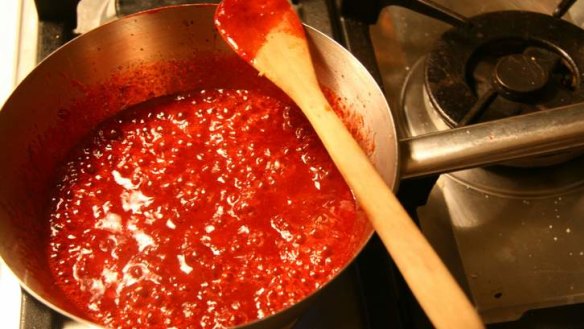The fruits of your labour

Jam making has a long history, and you can be part of it with just a few items of equipment, time and attention to detail. We've been busy making apricot, cherry and mulberry jams. As the season progresses, we hope to make peach, nectarine, plum and fig jams from our fruit. We've also made strawberry, loganberry, raspberry and youngberry jams from the berry patches. In autumn, we make apple and quince jellies.
You can also make jam from passionfruit, grape, melon and ginger, rosella, pawpaw and mango, and marmalades. The Buderim co-operative has a good recipe for tomato and ginger jam, and I have seen an interesting recipe attributed to the Canberra and District Historical Society for carrot and lemon jam.
Recently, I took my 95-year-old mother on a tour of Old Government House in Parramatta, where jam making is a part of its history. The first cottage was built in 1790 and the existing buildings constructed after a fire, serving as a retreat for governors of NSW until the 1850s. Orchards and gardens were established early, and within 30 years there were close to 500 hectares across NSW.
> Owen Pidgeon runs the organic Loriendale Orchard near Hall.
To make jam
The best fruit and berries for jam are those just becoming fully ripe, when the pectin levels are highest - essential for setting. Fruits such as apricots and plums are naturally high in pectin; others such as cherries might require pectin added. You can use the juice of a lemon or grapefruit, or buy a packet of Jamsetta from the supermarket.
Check for skin spots, cracks and imperfections. Cut these out. Do not include fruit that has signs of mould.
Equipment
Use a stainless-steel pot. You can buy large pots from catering shops in Fyshwick - it should take the fruit and sugar and still have about half the volume unused in case the jam boils up too quickly. Do not use aluminium pots as this is not a secure metal.
Sterilising your jars
Jars must be perfectly clean and sterilised. Wash the jars and lids with hot soapy water and rinse. Then pour boiling water into each jar and across each lid. Drain the water and place the jars horizontally in the oven at 100-120 degrees for eight to 10 minutes. Remove one by one for immediate use.
Making the jam
When you are working with large fruit such as apricots, split them in half and remove the seeds. With clingstone peaches, slice off the flesh in chunks. Pip cherries first. When making plum jam, simply add the whole fruit into the pot and skim off the seeds when the jam is cooking.
Fruit to sugar ratios
Many older books recommended a 50:50 ratio of fruit to jam. We have reduced the sugar contribution to 40 per cent as the jam still remains well preserved for a year or more and the ripe fruits contribute fructose as well.
Cooking the jam
Add the fruit and sugar to the pot, allow to sit for an hour, stir well, then bring to the boil. Boil for an hour or up to 90 minute. When the jam is nearly cooked, carefully mash the fruit with a stainless-steel masher. Do not overmash; leave some chunky pieces of fruit. Skim off any frothy residue on top towards the end of cooking time.
The setting test
Jams become thicker as they cool down in the jars. To test whether the jam is the right consistency for bottling, scoop out a teaspoon and drop it on to a chilled saucer. Place the saucer into your freezer for one or two minutes. If the jam is ready, it will not run when you tip the saucer sideways.
Bottling
Bottle the jam quickly using a sterilised cup or dedicated jug. Fill each jar nearly to the top. Use a cotton kitchen glove to protect your hands. Use a small spoon to run around the inside edge of the jam to remove any residue, then screw on the lid tightly.
In the garden
■ Keep up a deep watering regime during summer. Check to see that mulch applied in late spring is keeping the garden moist and weeds at bay, and add extra mulch around the garden beds. Sugar cane mulch from Queensland is a good option.
■ Plant seeds of mixed lettuces (or a punnet of seedlings) to keep a supply of salads. Plant rocket, Asian greens and leeks. Plant another row or two of beans if you have space.
■ Spend a few minutes each week tying the branches of your tomatoes to stakes and removing unwanted laterals.
■ Begin planting seeds of winter vegetables such as cabbage, cauliflower and broccoli to get them established before the cool nights of autumn set in.
■ Keep checking your apple trees. Remove and dispose of any apples with codling moth.